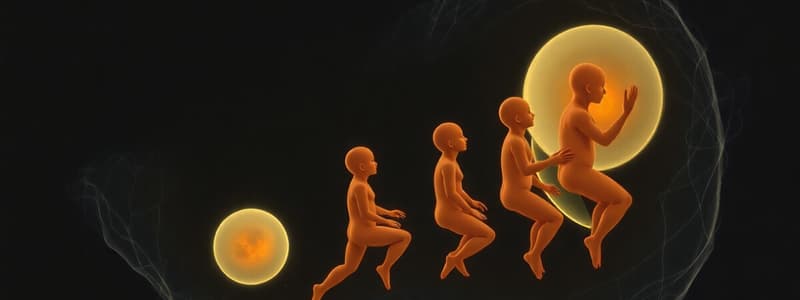Podcast
Questions and Answers
¿En qué día comienza la división del cigoto en blastómeros después de la fecundación?
¿En qué día comienza la división del cigoto en blastómeros después de la fecundación?
- 12 horas
- 30 horas (correct)
- 48 horas
- 24 horas
¿Cuál es la forma embrionaria que anida en el endometrio?
¿Cuál es la forma embrionaria que anida en el endometrio?
- Cigoto
- Trofoblasto
- Blástula (correct)
- Mórula
¿Qué tipo de células resulta de la masa celular externa (MCE)?
¿Qué tipo de células resulta de la masa celular externa (MCE)?
- Células trofoblásticas (correct)
- Células del embrión
- Células mitóticas
- Células del disco embrionario
¿Qué sucede a la masa celular interna (MCI) después de la segmentación?
¿Qué sucede a la masa celular interna (MCI) después de la segmentación?
¿Cuál es la función principal de la MCE durante la implantación?
¿Cuál es la función principal de la MCE durante la implantación?
¿Qué ocurre con el citoplasma del cigoto a medida que se segmenta?
¿Qué ocurre con el citoplasma del cigoto a medida que se segmenta?
¿Cuándo inicia la implantación del blastocisto en la mucosa uterina?
¿Cuándo inicia la implantación del blastocisto en la mucosa uterina?
¿Cuál de las siguientes afirmaciones sobre la segmentación es correcta?
¿Cuál de las siguientes afirmaciones sobre la segmentación es correcta?
Flashcards
Segmentación
Segmentación
Proceso de división celular que ocurre en el cigoto, generando blastómeros con el mismo citoplasma inicial.
Mórula
Mórula
Etapa de 16-32 células que se forma durante la segmentación, con una apariencia similar a una mora.
Blástula/Blastocisto
Blástula/Blastocisto
Estructura que se forma en la segmentación, con una cavidad interna llamada blastocele. Se compone de la masa celular externa (MCE) y la masa celular interna (MCI).
Masa celular externa (MCE)
Masa celular externa (MCE)
Signup and view all the flashcards
Masa celular interna (MCI)
Masa celular interna (MCI)
Signup and view all the flashcards
Implantación
Implantación
Signup and view all the flashcards
Trofoblasto
Trofoblasto
Signup and view all the flashcards
Placenta
Placenta
Signup and view all the flashcards
Study Notes
Segmentation and Nidation
- In identical twins, cell segmentation occurs very early. In conjoined twins, it occurs later.
- After ovulation, the zygote divides mitotically, increasing the number of cells (blastomeres). Early cells share the initial cytoplasm, which diminishes as cell division continues. This segmentation process stops unless implantation occurs, as the cytoplasm is depleted.
- The distance from the fallopian tube is significant in estimating time frames.
- Zygote segmentation into blastomeres starts about 30 hours after fertilization.
- Day 0: Zygote (single cell)
- Days 1-4: Morula (16-32 cells, blackberry-like)
- Days 4-5: Blastocyst/Blastula/Blastocele
- The structure changes as fluid fills the morula becoming a blastula.
Blastocyst Formation
- The blastocyst (immature form/blastula + cyst cavity) appears around day 5, floating freely in the uterine cavity.
- The outer layer is the trophoblast, crucial for implantation, initiating contact with the mother's body.
- The inner cell mass (ICM) is the true developing embryo/ early embryonic disk.
- The ICM will develop into the embryo itself, while the trophoblast is not part of the developing embryo, but an essential support structure. It will become the placenta.
Second Week Development
- Implantation begins around day 6, with the blastocyst embedding into the uterine lining.
- The trophoblast differentiates into two layers, the cytotrophoblast and the syncytiotrophoblast.
- The inner cell mass (ICM) differentiates into two layers, the hypoblast and epiblast, resulting in a bilaminar embryonic disc.
- The amniotic sac and yolk sac form.
Studying That Suits You
Use AI to generate personalized quizzes and flashcards to suit your learning preferences.




